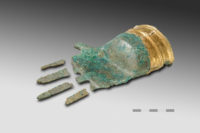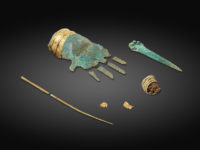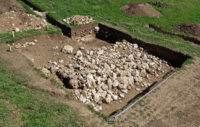 The earliest metal representation of a body part in Europe, a hand from the Bronze Age, has been discovered in the Canton of Bern, Switzerland. It was cast from more than a pound of bronze and has a gold foil cuff around the wrist and dates to around 3,500 years ago.
The earliest metal representation of a body part in Europe, a hand from the Bronze Age, has been discovered in the Canton of Bern, Switzerland. It was cast from more than a pound of bronze and has a gold foil cuff around the wrist and dates to around 3,500 years ago.
The bronze hand, a bronze dagger and a human rib were found together by metal detectorists in 2017 near Lake Biel in the Bernese Jura. The finders handed them in (pun not intended but it stays) to the Archaeological Service of the Canton of Bern. Experts had never seen anything like the hand. There were no comparable artifacts to assess its age according to its style, but the archaeologists were able to date it thanks to the vegetable adhesive used to connect the gold cuff to the bronze hand. The organic material was radiocarbon tested and the results came back with an estimated date of 1500-1400 B.C.
The human rib dated to about a hundred years earlier than that and the dagger can be stylistic dated to the same general period as the hand and rib: the Middle Bronze Age. The alloys used to cast the bronze of the hand are also characteristic of Bronze Age metallurgy.
 The Archaeological Service excavated the find site near the village of Prêles this spring and found the disturbed grave containing the skeletal remains of an adult male. Buried with him was a bronze clothes-fastening pin, a bronze spiral that was likely a hair tie and fragments from a gold sheet. There was also a single bronze finger. The gold sheet fragments and the finger identified the grave as the original location of the bronze hand.
The Archaeological Service excavated the find site near the village of Prêles this spring and found the disturbed grave containing the skeletal remains of an adult male. Buried with him was a bronze clothes-fastening pin, a bronze spiral that was likely a hair tie and fragments from a gold sheet. There was also a single bronze finger. The gold sheet fragments and the finger identified the grave as the original location of the bronze hand.
Metal objects in Bronze Age burials are rare, and gold is almost never found in Bronze Age burials in Switzerland. As far as Swiss archaeologists familiar with the find can tell, a sculpture like this is unique in Europe, and perhaps beyond. “The fact that we know of thousands of Bronze Age graves and have never found anything like this shows it’s pretty special,” says Stefan Hochuli, head of the Department of Monument Preservation and Archaeology in the nearby Swiss canton of Zug.
 Underneath the tomb was a stone structure that significantly pre-dated the death and burial of the adult man. It seems the individual was deliberately buried on top of the structure, singling him out as a person of great importance in his society.
Underneath the tomb was a stone structure that significantly pre-dated the death and burial of the adult man. It seems the individual was deliberately buried on top of the structure, singling him out as a person of great importance in his society.
It is not yet known whether the hand was locally made in the Lake Biel area or whether it was an expensive and rare import. Certainly nothing like it has ever been found in Switzerland before. Experts from Germany and France have also been consulted and they know of nothing similar found in their countries either. Its symbolic meaning and/or function are also unknown at this time. The gold cuff signals societal elite, or perhaps even a representation of a deity. The hollow cast of the bronze with a socket inside indicates it was originally mounted on a long, slender object like a stake or scepter. It could also have been part of a larger statue.
The hand is now on display at the Neues Museum Biel. It will be a brief stay. Visitors can see it there through October 14th, after which it will be removed for further study and scientific testing in the hopes of answering some of the lingering questions about this mysterious object.